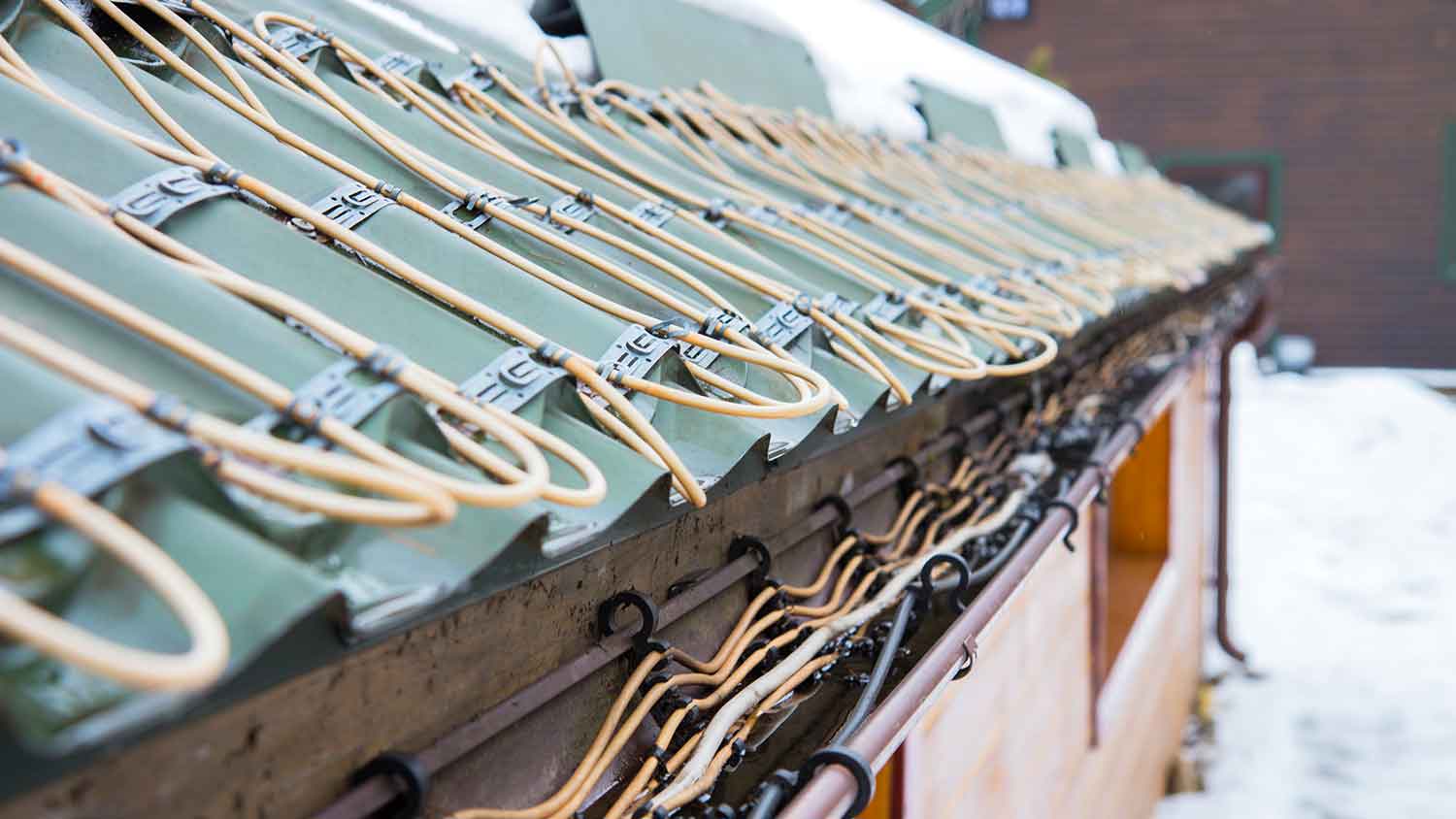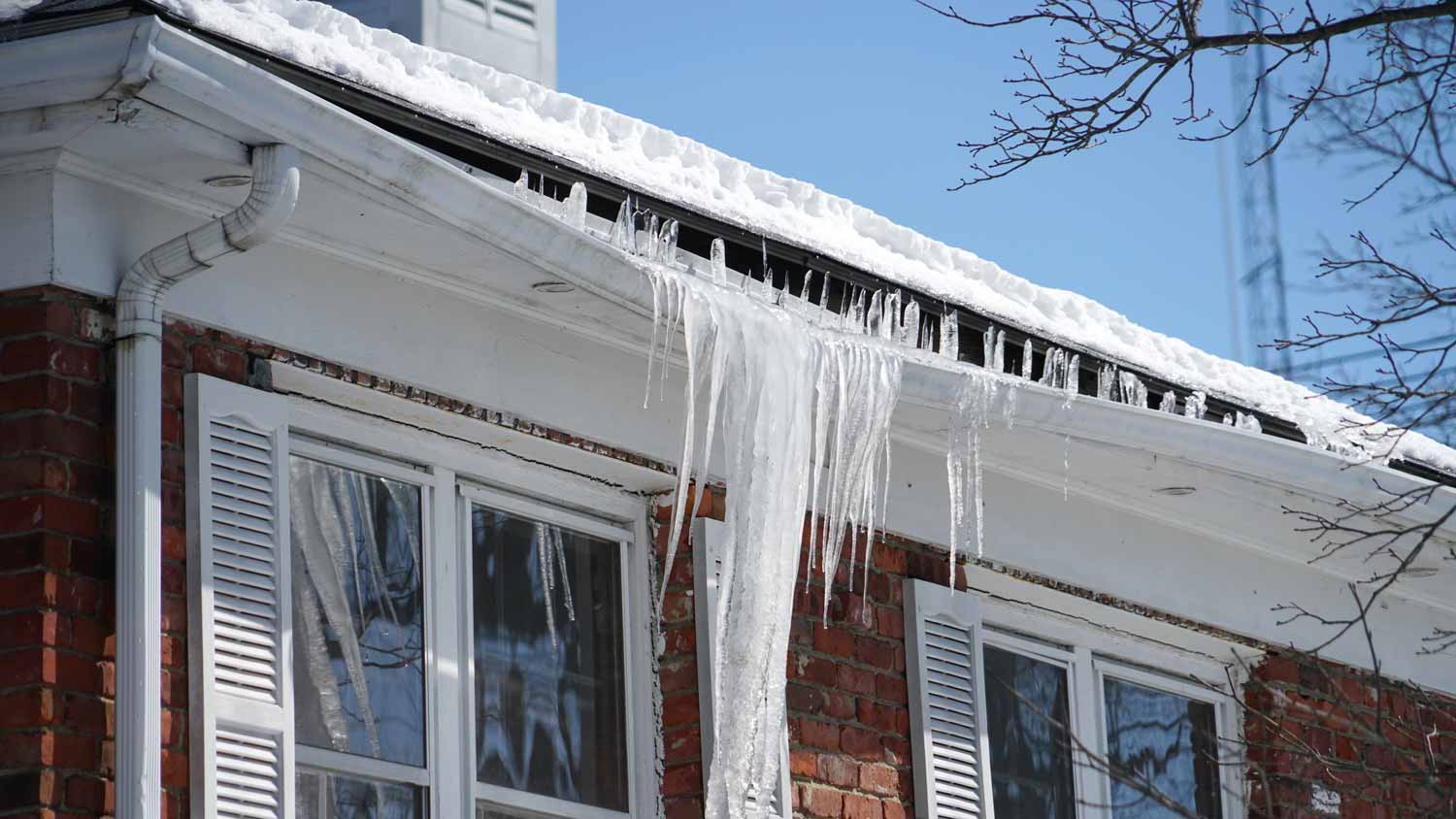
Discover the average roof heating cable installation cost, key price factors, and how to budget for your project. Learn how to save and what to expect.
Don’t be left out in the cold when it comes to understanding these two winter hazards


Ice dams and icicles form from melted snow or ice refreezing at the edge of the roof.
Improper attic insulation, clogged gutters, and roof slope can all cause ice formation.
Icicles are less likely to cause interior damage than ice dams but pose a safety risk.
Fresh snow and ice can make it look like a winter wonderland when you look out your window, but when they’re on your roof, they become a lot less magical. Ice dams and icicles are both ice formations that can cause damage to your home. Learn the difference between ice dams and icicles so you can prevent and remove them before they cause big problems.
While both of these types of ice formations can appear after winter weather, they’re very different. Ice dams are thick, solid chunks of ice that form at the edge of the roof and force water underneath the shingles. Icicles are usually found hanging from the roof’s eaves and gutters, anchored at the top of the icicle, and hanging freely down into open air.
| Type of Difference | Ice Dams | Icicles |
|---|---|---|
| Location | Roof edge and shingles | Gutters and eaves |
| Shape | Chunk | Cone-shaped |
| Size/Density | Large/thick | Long/thin |
Ice dams and icicles are both caused by melting snow or ice that refreezes close to the roof’s edge once temperatures drop again, usually at night. Different factors contribute to forming these two types of ice, however.
Attic temperature plays a large role in ice dam formation. Snow and ice melt when warm air escapes from the roof, then refreeze once they reach a colder area at the edge of the roof. Improperly ventilated or insulated attics create heat under snow and ice, causing it to quickly melt and then quickly refreeze once the temperature underneath drops again.
Icicles often form on houses with steeply sloped roofs. Sun hitting a snowy roof causes rivers of melted water, which refreezes as it drops off the roof and hits the icy air. Ice dams are more likely to form on lower sloped roofs, as they’re usually less ventilated, and drainage is slower than on steep roofs.
Gutters that are clogged with large chunks of ice can contribute to both icicles and ice dams. When gutters are blocked, melting water has nowhere to properly drain, so it flows over the gutter and off the roof to form icicles, or it refreezes and backs up onto the roof in large chunks, causing ice dams.

While ice dams and icicles are both unwelcome sights when it comes to your roof, they can pose risks for different kinds of damage.
Ice dams can force melted water to run underneath chunks of frozen ice, unable to drain off the roof properly. This water gets forced up under shingles, saturating the roof deck, and potentially leaking into your home’s interior, running between walls, into the attic, and other areas of your home.
Ice dams and icicles can both damage your gutters. The weight of ice in any form can pull the gutters away from your roof. Since ice dams are heavier and take longer to melt, they can damage your gutter system the most.
Any water that makes its way under your roof can cause mold, mildew, or fungus growth. This is a particular worry for ice dams since they’re more likely to cause water intrusion than icicles.
Icicles can be bad for your roof, but they can be even worse for you and your family. As you can imagine, pointy, heavy icicles that are able to fall from stories high without warning pose quite a safety risk. Icicles that form over walkways or other heavily trafficked areas can fall and shatter whenever they melt enough or get heavy enough to detach from the eaves or gutters. They then leave ice on the ground, which itself poses a risk of slips and falls.

Preventing ice formation is key to preventing the damage that ice dams and icicles can cause.
To prevent ice dams:
Ensure your attic is properly insulated and ventilated to provide a consistent temperature
Keep gutters and downspouts clear of ice and snow
Use a snow rake or brush to clear the roof after snow
Clear gutters in the fall to remove leaves and other debris that can clog them
Use roof heating cables to keep water from refreezing once melted and to keep gutters clear
To prevent icicles:
Keep gutters clear of ice and debris
Use gutter heat tape to keep gutters above freezing and keep water moving in freezing temperatures
If your prevention methods don’t work, you’ll want to remove these ice formations before they cause damage. Keep in mind that freezing, icy conditions can pose serious safety risks, so call in a local snow removal pro for dangerous tasks that involve climbing a ladder or getting on an icy roof.
You can knock down icicles, particularly those in high-traffic areas, with a long-handled tool used at a safe distance and from a safe angle where you don’t risk the icicle falling on you.
Ice dams are more difficult to remove since they require getting up on the roof. Play it safe by hiring a pro to remove ice dams—the cost to remove ice dams will save you from expensive repair bills and potentially serious injuries. If you see signs of an ice dam, don’t try to handle it yourself.
Your attic should be similar temperature to outside, which eliminates the melting on the roof which then will eliminate the ice problems. Keeping your attic cold through insulation on the attic floor and properly functioning ventilation is the solution.
From average costs to expert advice, get all the answers you need to get your job done.

Discover the average roof heating cable installation cost, key price factors, and how to budget for your project. Learn how to save and what to expect.

Protect your home and roof this winter. Learn when and how to remove snow from your roof with these tips for using snow rakes, de-icer, and a simple rope.

Knowing the signs of an ice dam on your roof can help prevent serious damage. Learn what to look for to spot a problem early.

In this article, we will answer the question, “What are snow guards?” and walk you through whether or not you need them on your roof.

Wondering how to prevent icicles on roofs? While you can't keep it from snowing, you can take steps to keep the icicles at bay. Find out how.

In this guide, find out how much snow a roof can hold so you can keep your home and family safe this winter when the snow starts falling.